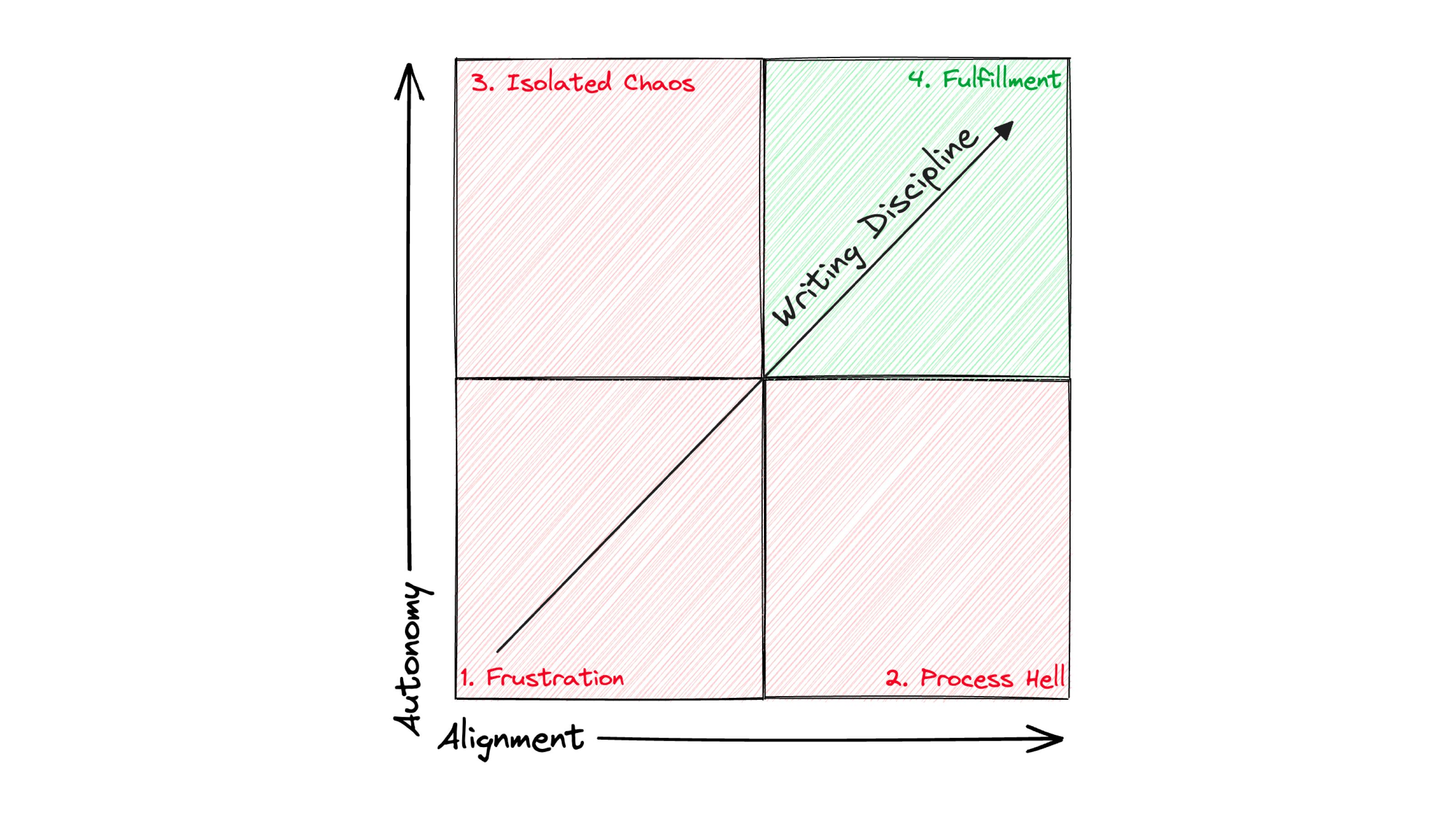Team alignment leads to autonomy, which leads to individual and collective fulfillment. Zoom fatigue and the cost of unnecessary meetings are well documented scourges to knowledge worker fulfillment but there is an antidote, greater writing discipline.
Teams struggle to achieve sufficient alignment by overly relying on real-time communication mediums, such as meetings or chat. You and your teammates simply need more time than these exchanges provide to think about strategic and tactical topics.
Greater writing discipline leads to more efficiency asynchronous communication and clearer thinking. Amazon is famous for its writing culture, with Jeff Bezos sharing the following when he allegedly banned Powerpoint use:
Teams struggle to achieve sufficient alignment by overly relying on real-time communication mediums, such as meetings or chat. You and your teammates simply need more time than these exchanges provide to think about strategic and tactical topics.
Greater writing discipline leads to more efficiency asynchronous communication and clearer thinking. Amazon is famous for its writing culture, with Jeff Bezos sharing the following when he allegedly banned Powerpoint use:
The reason writing a 4-page memo is harder than “writing” a 20 page powerpoint is because the narrative structure of a good memo forces better thought and better understanding of what’s more important than what, and how things are related. – source
1. Frustration: Low Alignment & Low Autonomy
This is the shittiest place to be and eventually you and your team will wonder why you're starting work in the morning. If you're here then something needs to change and quickly.
It's difficult for a company with any sort of product market fit to be here, since user demands will lead to a baseline level of priority alignment. A small startup may be here if product market fit has remained elusive and founders can't align on what to do next.
To exit this quadrant a team needs to stop building and start with the why behind their business. Answering "What problem are we solving?", "Who has that problem?", "Is solving that problem valuable?" may clarify next steps.
It's difficult for a company with any sort of product market fit to be here, since user demands will lead to a baseline level of priority alignment. A small startup may be here if product market fit has remained elusive and founders can't align on what to do next.
To exit this quadrant a team needs to stop building and start with the why behind their business. Answering "What problem are we solving?", "Who has that problem?", "Is solving that problem valuable?" may clarify next steps.
2. Process Hell: High Alignment & Low Autonomy
This quadrant could be renamed to "activity over output". Team members are busy attending meetings, filing and updating tickets, and providing status updates. There is insufficient time to think deeply and uncover higher impact opportunities.
To exit this quadrant a team needs to start measuring more. Auditing the amount of time spent on process and establishing objective measures for impact may clarify for the group that activity is being prioritized over output.
To exit this quadrant a team needs to start measuring more. Auditing the amount of time spent on process and establishing objective measures for impact may clarify for the group that activity is being prioritized over output.
3. Isolated Chaos: Low Alignment & High Autonomy
This quadrant can be fun and energizing for a time but substantial impact will remain elusive in a team setting. Successful independent entrepreneurs don't live in this quadrant, while they don't need to align with teammates they are tightly aligned with what matters most to their business.
Exiting this quadrant requires more process, which can sound scary but can be lightweight. Adopting the principles of Shape Up may be a good starting point since it can align teams around bets they want to make in a specific time period.
Exiting this quadrant requires more process, which can sound scary but can be lightweight. Adopting the principles of Shape Up may be a good starting point since it can align teams around bets they want to make in a specific time period.
4. Fulfillment: High Alignment & High Autonomy
This is the magic quadrant, where the right balance of alignment and autonomy has been achieved and team members with varying skillsets get to do their best work.
Product managers have identified and scoped an impactful opportunity, designers are getting to creatively solve an important user problem, and engineers are getting to solve interesting technical problems without spending the majority of their day writing status updates.
Striving for perfect team alignment is analogous to the race car driver Ken Miles' pursuit of the perfect lap. You can't make it perfect every time, "but I can try".
Product managers have identified and scoped an impactful opportunity, designers are getting to creatively solve an important user problem, and engineers are getting to solve interesting technical problems without spending the majority of their day writing status updates.
Striving for perfect team alignment is analogous to the race car driver Ken Miles' pursuit of the perfect lap. You can't make it perfect every time, "but I can try".
